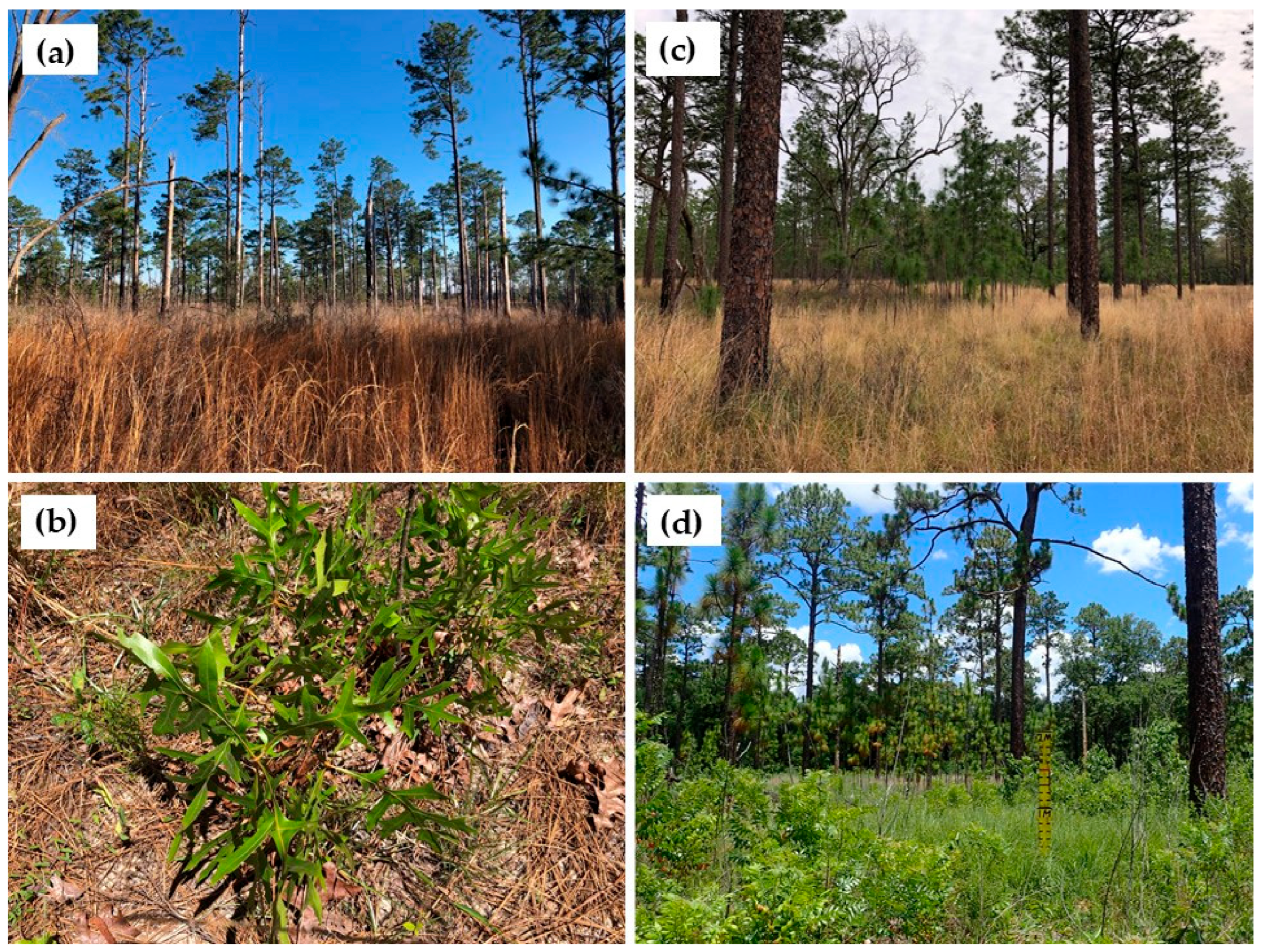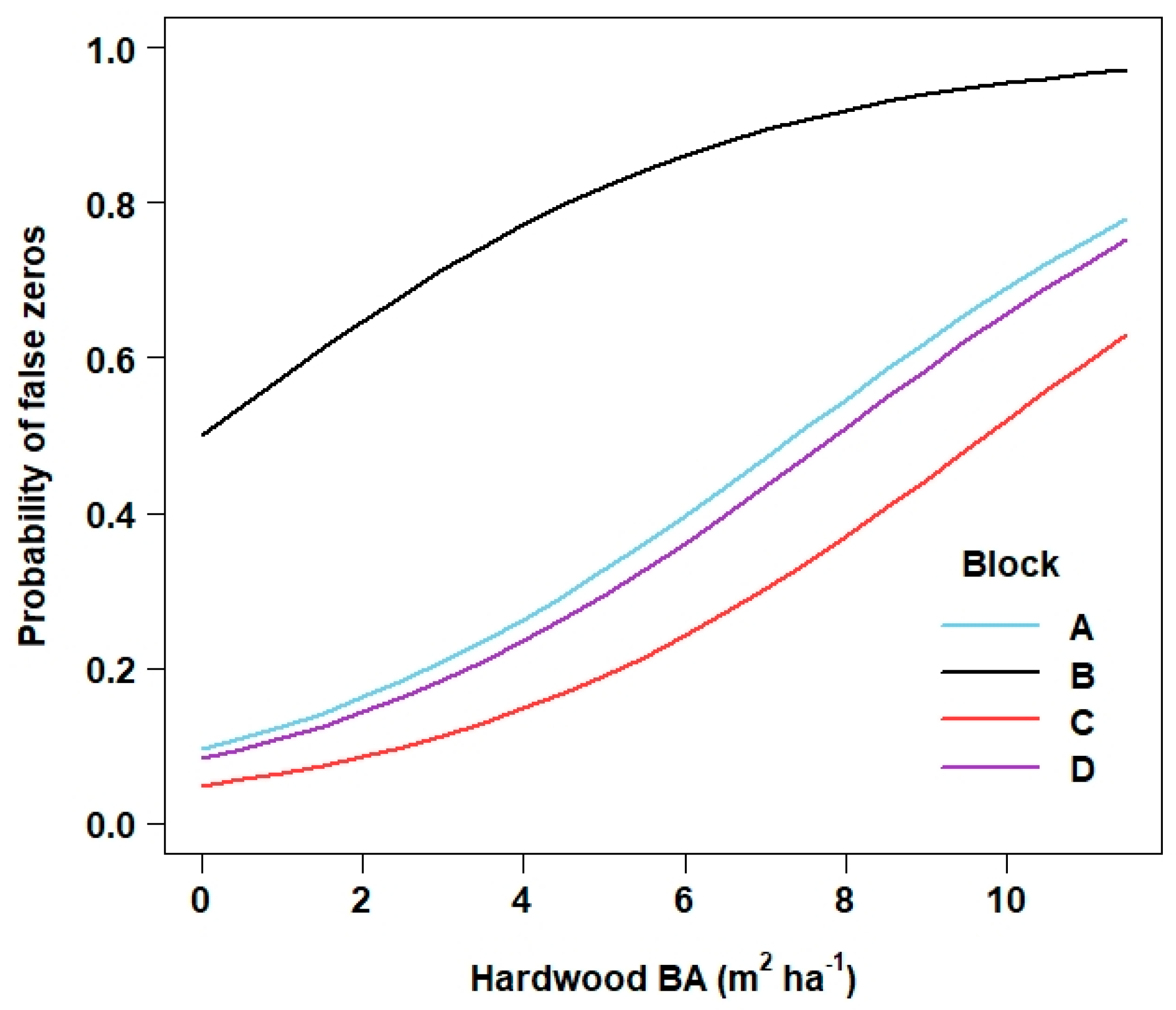Forestry Assisted Migration in a Longleaf Pine Ecosystem
Abstract
1. Introduction
2. Materials and Methods
2.1. Study Area
2.2. Data Collection
2.3. Data Analyses
3. Results
3.1. Stand Conditions
3.2. Turkey Oak Stocking
3.3. Turkey Oak Counts
3.4. Longleaf Pine Stocking
4. Discussion
4.1. Transition Approaches
4.2. Turkey Oak Regeneration
4.3. Longleaf Pine Regeneration
5. Conclusions
Author Contributions
Funding
Data Availability Statement
Acknowledgments
Conflicts of Interest
References
- Barbarika, A.; Farm Service Agency. The Conservation Reserve Program: A 35-Year History; USDA: Washington, DC, USA, 2021; p. 21. [Google Scholar]
- Puhlick, J.J.; Markewitz, D.; Taylor, R.S. Soil change after planting longleaf pine on agricultural lands: Revisiting a chronosequence study after 23 years. Soil Sci. Soc. Am. J. 2025, 89, e70062. [Google Scholar] [CrossRef]
- Kush, J.S.; Meldahl, R.S.; McMahon, C.K.; Boyer, W.D. Longleaf pine: A sustainable approach for increasing terrestrial carbon in the southern United States. Environ. Manage. 2004, 33, S139–S147. [Google Scholar] [CrossRef]
- Puhlick, J.J.; O’Halloran, T.L.; Starr, G.; Abney, R.B.; Knapp, L.P.; McCleery, R.A.; Klepzig, K.D.; Brantley, S.T.; McIntyre, R.K.; Song, B. Opportunities for research on carbon management in longleaf pine ecosystems. Forests 2023, 14, 874. [Google Scholar] [CrossRef]
- Condon, B.; Putz, F.E. Countering the broadleaf invasion: Financial and carbon consequences of removing hardwoods during longleaf pine savanna restoration. Restor. Ecol. 2007, 15, 296–303. [Google Scholar] [CrossRef]
- Kirkman, L.K.; Giencke, L.M.; Taylor, R.S.; Boring, L.R.; Staudhammer, C.L.; Mitchell, R.J. Productivity and species richness in longleaf pine woodlands: Resource-disturbance influences across an edaphic gradient. Ecology 2016, 97, 2259–2271. [Google Scholar] [CrossRef] [PubMed]
- Nagel, L.M.; Palik, B.J.; Battaglia, M.A.; D’Amato, A.W.; Guldin, J.M.; Swanston, C.W.; Janowiak, M.K.; Powers, M.P.; Joyce, L.A.; Millar, C.I.; et al. Adaptive Silviculture for Climate Change: A national experiment in manager-scientist partnerships to apply an adaptation framework. J. For. 2017, 115, 167–178. [Google Scholar] [CrossRef]
- Bower, A.D.; Frerker, K.L.; Pike, C.C.; Labonte, N.R.; Palik, B.J.; Royo, A.A.; Anderson, S.M.; Ferreira, A.R.; Brandt, L.A. A practical framework for applied forestry assisted migration. Front. For. Glob. Change 2024, 7, 1454329. [Google Scholar] [CrossRef]
- Balloffet, N.; Dumroese, R.K. The national reforestation strategy and the REPLANT Act: Growing and nurturing resilient forests. In Foundational Concepts in Silviculture with Emphasis on Reforestation and Early Stand Improvement—2022 National Silviculture Workshop Proceedings; Jain, T.B., Schuler, T.M., Eds.; USDA Forest Service, Rocky Mountain Research Station: Fort Collins, CO, USA, 2022; p. 3. [Google Scholar]
- Palik, B.J.; Clark, P.W.; D’Amato, A.W.; Swanston, C.; Nagel, L. Operationalizing forest-assisted migration in the context of climate change adaptation: Examples from the eastern USA. Ecosphere 2022, 13, e4260. [Google Scholar] [CrossRef]
- Pedlar, J.H.; McKenney, D.W.; Aubin, I.; Beardmore, T.; Beaulieu, J.; Iverson, L.; O’Neill, G.A.; Winder, R.S.; Ste-Marie, C. Placing forestry in the assisted migration debate. Bioscience 2012, 62, 835–842. [Google Scholar] [CrossRef]
- Williams, M.I.; Dumroese, R.K. Preparing for climate change: Forestry and assisted migration. J. For. 2013, 111, 287–297. [Google Scholar] [CrossRef]
- Reynolds, S.A. Turkey oak (Quercus laevis W.) seedlings experience primarily competitive pressures, not facilitation, from the overstory in a longleaf pine (Pinus palustris M.) ecosystem. Master’s Thesis, Auburn University, Auburn, AL, USA, 2020. [Google Scholar]
- Zuur, A.F.; Ieno, E.N.; Walker, N.J.; Saveliev, A.A.; Smith, G.M. Mixed Effects Models and Extensions in Ecology with R; Springer: New York, NY, USA, 2009. [Google Scholar]
- Zeileis, A.; Kleiber, C.; Jackman, S. Regression models for count data in R. J. Stat. Softw. 2008, 27, 1–25. [Google Scholar] [CrossRef]
- Zeileis, A.; Hothorn, T. Diagnostic checking in regression relationships. R. News 2002, 2, 7–10. [Google Scholar]
- Keeley, J.E. Ecology and evolution of pine life histories. Ann. For. Sci. 2012, 69, 445–453. [Google Scholar] [CrossRef]
- Crotteau, J.S.; Sutherland, E.K.; Jain, T.B.; Wright, D.K.; Jenkins, M.M.; Keyes, C.R.; Nagel, L.M. Initiating climate adaptation in a western larch forest. For. Sci. 2019, 65, 528–536. [Google Scholar] [CrossRef]
- Palik, B.J.; Kastendick, D.N.; Kragthorpe, J. Comparing performance of assisted migration seed sources of two oak species in a Minnesota red pine woodland. New For. 2024, 55, 1875–1885. [Google Scholar] [CrossRef]
- Croker, T.C., Jr.; Boyer, W.D. Regenerating Longleaf Pine Naturally; USDA Forest Service, Southern Forest Experiment Station: New Orleans, LA, USA, 1975; p. 26. [Google Scholar]
- Brockway, D.G.; Outcalt, K.W.; Boyer, W.D. Longleaf pine regeneration ecology and methods. In Ecology, Silviculture, and Restoration; Shibu, J., Jokela, E.J., Miller, D.L., Eds.; Springer: New York, NY, USA, 2006; pp. 95–133. [Google Scholar]
- Gagnon, J.L.; Jokela, E.J.; Moser, W.K.; Huber, D.A. Characteristics of gaps and natural regeneration in mature longleaf pine flatwoods ecosystems. For. Ecol. Manage. 2004, 187, 373–380. [Google Scholar] [CrossRef]
- Puhlick, J.J.; Laughlin, D.C.; Moore, M.M. Factors influencing ponderosa pine regeneration in the southwestern USA. For. Ecol. Manage. 2012, 264, 10–19. [Google Scholar] [CrossRef]




| Model 1 | ai (SE) | |||
|---|---|---|---|---|
| Block A | Block B | Block C | Block D | |
| ai −0.26681 (Hwd BA) | 1.95110 (0.29585) | −0.52034 (0.37972) | 2.41012 (0.43690) | 2.02955 (0.40193) |
| Slope SE | Null Deviance | Residual Deviance | ||
| 0.10176 | 414.51 | 324.67 | ||
| Model | Hwd BA | Block A | Block B | Block C | Block D |
|---|---|---|---|---|---|
| Count | NA | 1.23301 | −0.94068 | −0.04770 | −0.07151 |
| Zero-inflated | −0.30516 | −2.2533 | 2.25205 | −0.72192 | −0.14811 |
Disclaimer/Publisher’s Note: The statements, opinions and data contained in all publications are solely those of the individual author(s) and contributor(s) and not of MDPI and/or the editor(s). MDPI and/or the editor(s) disclaim responsibility for any injury to people or property resulting from any ideas, methods, instructions or products referred to in the content. |
© 2025 by the authors. Licensee MDPI, Basel, Switzerland. This article is an open access article distributed under the terms and conditions of the Creative Commons Attribution (CC BY) license (https://creativecommons.org/licenses/by/4.0/).
Share and Cite
Holbrook, A.S.; Puhlick, J.J. Forestry Assisted Migration in a Longleaf Pine Ecosystem. Forests 2025, 16, 932. https://doi.org/10.3390/f16060932
Holbrook AS, Puhlick JJ. Forestry Assisted Migration in a Longleaf Pine Ecosystem. Forests. 2025; 16(6):932. https://doi.org/10.3390/f16060932
Chicago/Turabian StyleHolbrook, Avery S., and Joshua J. Puhlick. 2025. "Forestry Assisted Migration in a Longleaf Pine Ecosystem" Forests 16, no. 6: 932. https://doi.org/10.3390/f16060932
APA StyleHolbrook, A. S., & Puhlick, J. J. (2025). Forestry Assisted Migration in a Longleaf Pine Ecosystem. Forests, 16(6), 932. https://doi.org/10.3390/f16060932






